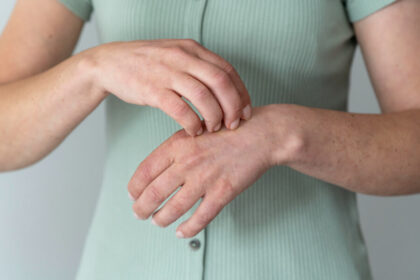Inguinal hernia is a condition where a part of the intestines or abdominal tissue protrudes through a weak spot in the lower abdominal wall, specifically in the groin area.
It typically manifests as a bulge or swelling in the groin or scrotum.
They are more common in males and often occur due to a weakness in the abdominal muscles.
Activities that increase abdominal pressure, such as heavy lifting, can exacerbate or cause hernias.
While not generally life-threatening, they can cause discomfort, pain, and complications if the hernia becomes trapped or incarcerated, obstructing the intestines.
Causes
The causes can be attributed to a combination of factors.
The primary cause is a weakness or defect in the abdominal muscles that allows abdominal tissues or organs to protrude through.
Some factors that contribute to this weakness include:
Congenital Weakness
Some individuals are born with a natural weakness in the abdominal wall, making them more susceptible to developing hernias.
Age
As individuals age, their abdominal muscles can weaken, increasing the risk of developing an inguinal hernia.
Gender
Inguinal hernias are more common in males due to the natural anatomy of the groin area. Men have a natural weakness where the spermatic cord passes through the abdominal muscles.
Heavy Lifting or Straining
Activities that increase intra-abdominal pressure, such as lifting heavy objects or constantly straining during bowel movements, can put stress on the abdominal wall and contribute to hernia development.
Chronic Coughing
Chronic and persistent coughing can weaken the abdominal muscles over time, increasing the likelihood of an inguinal hernia.
Pregnancy
The increased pressure on the abdomen during pregnancy can weaken the abdominal muscles and potentially lead to the development of an inguinal hernia.
It is important to note that while these factors increase the risk of inguinal hernia, an individual may develop a hernia even without any specific underlying cause.
Symptoms
The symptoms of an inguinal hernia can vary but typically include:
- A visible or palpable bulge or lump in the groin area.
- Feelings of pressure, discomfort, or heaviness in the groin or lower abdomen.
- Pain or a dull ache in the groin or abdomen, which may worsen with physical activity or lifting.
- Burning or aching sensation at the site of the hernia.
- Weakness or a dragging sensation in the groin.
- In some cases, the bulge may disappear when lying down or pushing it back into the abdomen but reappear when standing or coughing.
It is important to note that not all inguinal hernias cause symptoms, and they may vary in severity from person to person.
Prompt medical attention is recommended if symptoms develop or worsen.
Treatments
The primary treatment for an inguinal hernia is surgical repair, as hernias do not resolve on their own.
The specific procedure and technique used for repair will depend on various factors, including the size and type of hernia, as well as the individual’s overall health.
Common treatment options include:
Herniorrhaphy
During this procedure, the surgeon makes an incision in the groin, relocates the protruding tissues or organs back into the abdomen, and then reinforces the weakened abdominal wall with sutures or mesh.
Laparoscopic Hernia Repair
This minimally invasive technique involves making small incisions and using a laparoscope (a thin tube with a camera) and specialized surgical tools to repair the hernia.
This procedure may have a shorter recovery time compared to traditional open surgery.
Hernioplasty
In some cases, the surgeon may choose to reinforce the weakened abdominal wall with a surgical mesh during the repair.
This mesh provides additional support and reduces the risk of recurrence.
The choice of surgical technique will depend on factors such as the individual’s overall health, the size and complexity of the hernia, and the surgeon’s recommendation.
In certain situations where surgery is not immediately possible or if the hernia is small and not causing significant symptoms, a “watchful waiting” approach may be adopted under the supervision of a healthcare professional.
However, surgical repair is typically recommended to prevent potential complications such as incarceration or strangulation of the hernia contents.
Always consult with a healthcare professional for an accurate diagnosis and appropriate treatment plan for an inguinal hernia.
Tips for managing Inguinal Hernia
Here are a few general tips for managing inguinal hernia:
Consult your doctor
If you suspect you have an inguinal hernia or have been diagnosed with one, it is crucial to consult with your healthcare provider for an accurate diagnosis and personalized advice.
Watch for symptoms
Be aware of any symptoms such as a bulge or lump in the groin, pain or discomfort, or a dragging sensation.
Pay attention to any changes or worsening of symptoms and inform your doctor accordingly.
Manage weight and maintain a healthy lifestyle
Excess weight puts additional strain on the abdominal muscles, potentially worsening the hernia. Maintain a healthy weight through a balanced diet and regular exercise.
Avoid heavy lifting
Heavy lifting puts pressure on the abdominal wall and can worsen an inguinal hernia.
If you need to lift something heavy, ensure you use proper lifting techniques or ask for help.
Wear supportive undergarments
Wearing supportive underwear or a specially designed hernia belt or truss can help provide some support and relieve discomfort.
Practice good posture
Maintaining good posture can help alleviate strain on the hernia.
Practice proper sitting, standing, and lifting techniques to reduce pressure on the affected area.
Manage constipation and avoid straining during bowel movements
Constipation and straining during bowel movements can increase abdominal pressure and exacerbate hernia symptoms.
Eat a fiber-rich diet, stay hydrated, and if needed, use stool softeners or seek medical advice for managing constipation.
Avoid activities that increase intra-abdominal pressure
Activities such as coughing, sneezing, or straining during urination can put pressure on the hernia.
Be mindful of these activities and try to minimize strain.
Conclusion
Inguinal hernia is a condition characterized by the protrusion of abdominal tissue or organs through a weakened area in the lower abdominal wall.
While the exact causes may vary, factors such as congenital weakness, aging, gender, heavy lifting or straining, chronic coughing, and pregnancy can contribute to the development of inguinal hernias.
While inguinal hernias are more common in males, anyone can be affected by this condition.
It is essential to recognize the symptoms of an inguinal hernia, such as a noticeable bulge in the groin area, discomfort, or pain, and seek medical attention if experienced.
Although inguinal hernias are not typically life-threatening, complications can arise if the hernia becomes trapped or incarcerated.
Surgical intervention is the standard treatment for inguinal hernias, aiming to repair the weakened abdominal wall and prevent further complications.
Early detection and timely medical intervention play a crucial role in managing inguinal hernias effectively.
Awareness of the causes, risk factors, and symptoms of inguinal hernias is important for individuals to take necessary precautions, such as avoiding heavy lifting or seeking treatment for chronic coughing.
With proper understanding and prompt medical care, individuals can improve their quality of life and reduce the potential complications associated with inguinal hernias.
FAQs
What is an inguinal hernia?
An inguinal hernia is a condition where tissue, typically part of the intestine, protrudes through a weak spot in the abdominal muscles, forming a bulge in the groin or scrotum.
What causes an inguinal hernia?
Inguinal hernias occur when there is a weak spot or opening in the abdominal muscles, which can be due to factors like aging, genetics, chronic coughing, heavy lifting or straining, and pregnancy.
How do I know if I have an inguinal hernia?
Common symptoms of an inguinal hernia include a visible bulge in the groin or scrotum, discomfort or pain in the groin area, and a feeling of heaviness or pressure.
Is surgery the only treatment for an inguinal hernia?
Surgery is the most effective treatment for an inguinal hernia. In some cases, a watchful waiting approach with lifestyle modifications and the use of trusses or belts may be recommended for individuals who are not suitable candidates for surgery.
Can an inguinal hernia go away on its own?
No, inguinal hernias do not typically resolve on their own and often require surgical repair to prevent complications.
Are inguinal hernias dangerous?
Inguinal hernias themselves are not dangerous. However, if left untreated, they can lead to complications such as obstruction or incarceration, where the hernia becomes trapped and unable to be pushed back into the abdomen.
What is the recovery period after hernia surgery?
The recovery period after hernia surgery varies, but it usually takes a few weeks to resume normal activities. Physical exertion and heavy lifting should be avoided for several weeks as advised by the surgeon.





